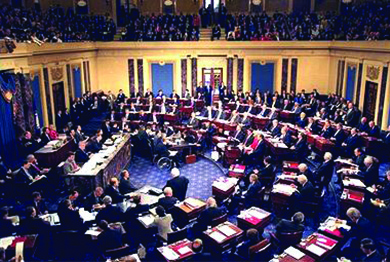IMPEACHMENT
Public attention was diverted from Clinton’s foreign policing actions by a series of scandals that marked the last few years of his presidency. From the moment he entered national politics, his opponents had attempted to tie Clinton and his First Lady to a number of loosely defined improprieties, even accusing him of murdering his childhood friend and Deputy White House Counsel Vince Foster. One accusation the Clintons could not shake was of possible improper involvement in a failed real estate venture associated with the Whitewater Development Corporation in Arkansas in the 1970s and 1980s. Kenneth Starr, a former federal appeals court judge, was appointed to investigate the matter in August 1994.
While Starr was never able to prove any wrongdoing, he soon turned up other allegations and his investigative authority was expanded. In May 1994, Paula Jones, a former Arkansas state employee, filed a sexual harassment lawsuit against Bill Clinton. Starr’s office began to investigate this case as well. When a federal court dismissed Jones’s suit in 1998, her lawyers promptly appealed the decision and submitted a list of other alleged victims of Clinton’s harassment. That list included the name of Monica Lewinsky, a young White House intern. Both Lewinsky and Clinton denied under oath that they had had a sexual relationship. The evidence, however, indicated otherwise, and Starr began to investigate the possibility that Clinton had committed perjury. Again, Clinton denied any relationship and even went on national television to assure the American people that he had never had sexual relations with Lewinsky.
However, after receiving a promise of immunity, Lewinsky turned over to Starr evidence of her affair with Clinton, and the president admitted he had indeed had inappropriate relations with her. He nevertheless denied that he had lied under oath. In September, Starr reported to the House of Representatives that he believed Clinton had committed perjury. Voting along partisan lines, the Republican-dominated House of Representatives sent articles of impeachment to the Senate, charging Clinton with lying under oath and obstructing justice. In February 1998, the Senate voted forty-five to fifty-five on the perjury charge and fifty-fifty on obstruction of justice (Figure). Although acquitted, Clinton did become the first president to be found in contempt of court. Nevertheless, although he lost his law license, he remained a popular president and left office at the end of his second term with an approval rating of 66 percent, the highest of any U.S. president.
